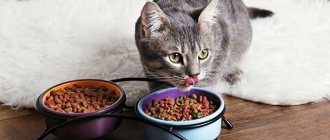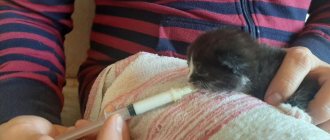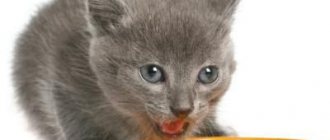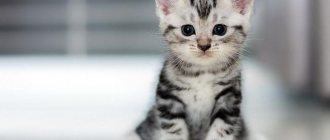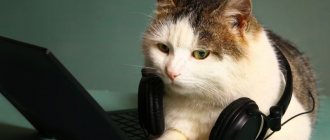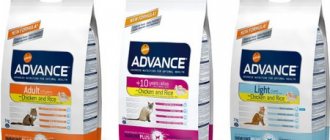Updated: 02/19/2020 11:33:00
Expert: Eliana Blum
*Review of the best according to the editors of expertology.ru. About the selection criteria. This material is subjective in nature, does not constitute advertising and does not serve as a purchase guide. Before purchasing, consultation with a specialist is required.
Pets always require extra care and attention. Loving owners try to choose a diet so that the food is balanced and contains all the useful elements necessary for normal life. In old age, it is necessary to change the diet and switch to food that is specially designed for older cats. With the right diet, you can significantly increase the life expectancy of an animal and make it full and of high quality.
The aging process leads to changes in the functioning of internal organs, and immunity decreases. To alleviate the condition, it is necessary to pay special attention to the composition of the feed. They should not be high in calories or contain components that affect the pancreas, liver and stomach. A formulation is also needed that would not provoke the formation of stones, leading to kidney failure and other irreversible processes. It should support the musculoskeletal system to reduce the unpleasant symptoms of joint diseases.
An adult animal will need additional elements that will add energy and strength for normal life. Based on many years of research, scientists create specialized foods that help cats remain active even after exceeding the threshold of 10 years. From the products on the market, our experts selected 12 that turned out to be the best in all respects. When compiling the list, reviews from breeders and the opinions of veterinarians were taken into account.
Features of feeding older cats
In order to properly formulate a cat’s diet after 7 years, you need to consult a veterinarian. An examination by a specialist will allow you to detect health problems, if any, and choose the appropriate food individually.
If you are predisposed to problems of the digestive system, the emphasis in nutrition should be on the presence of fiber in the product. If a cat has diseases associated with the cardiovascular system, the pet should be given food with taurine and a reduced percentage of sodium.
When an animal has problems related to the oral cavity and teeth, it is necessary to reconsider the consistency of the food. For such cats, only wet food is recommended, and dry food should be completely abandoned. Kidney disease is common in older cats. In this case, you need to provide the cat with a diet with easily digestible protein, with a minimum amount of phosphorus and magnesium salts.
The choice can be made by examining the ratings of canned food intended for feeding older cats. Almost all well-known companies that produce cat food offer food specifically designed for aging animals.
Changes in diet compared to youth
An older animal needs to be fed so that it eats less than a young animal, but by how much? This is determined by weight - for example, an aging cat should be given a full hundred grams less of food if it weighs 4 kg, 80 less if it weighs three, 120 less if it weighs five, and so on.
Also, his food should contain less fat and more fiber. The former should be abandoned if you continue to feed your old cat natural food. This method also helps well if the owner simply cannot leave his pet “hungry” and continues to feed him abundantly - reducing fat content will again help avoid obesity, which is threatened by age.
It is better to choose ready-made food for an elderly cat - everything in it is built according to this principle. If the food is 95% fat-free, this is good; such food will ensure that the cat looks healthy and is free from diseases for a long time.
Diet requirements for an aging cat
An older cat's diet must meet specific requirements. Should be considered:
- Calorie content. Cats begin to exercise less as they age, and excess calories can cause obesity. Excess weight negatively affects the joints, heart and liver, and can cause a reduction in life expectancy. On average, an aging cat should eat one-third less than when she was younger.
- Easily digestible components . Super premium food is suitable for feeding older cats, since such products contain natural and easily digestible ingredients that do not overload the liver and do not impair digestion due to insufficient enzyme production. It is forbidden to feed your pet raw meat, fatty foods, food containing salt or spices.
- Percentage of fiber in diet . Older cats develop constipation as a result of decreased intestinal motility. To normalize stool and intestinal microflora, about 5% fiber should be present in the diet of an elderly cat. It is necessary to provide the animal with free access to water, since it is very important that the pet drinks a lot of water during the day, especially if it eats dry food.
- Phosphorus and protein content in feed. According to statistics, cats often die from kidney disease. To prevent kidney disease, aging animals should be fed a diet low in phosphorus (maximum 0.7%) and protein (maximum 40%). Sharp restrictions that reduce the palatability of the feed and cause a deficiency of important amino acids are not recommended.
- Taste and attractiveness of food . In order to maintain your pet’s interest in food when the cat’s sense of smell begins to weaken, it is recommended to change food frequently, warm the food before feeding, and additionally flavor the food with fish broth.
- Availability of vitamins and food additives in food . Aging cats have trouble absorbing enough vitamins from their food. This is associated with vitamin deficiency even when using high-quality products. A lack of nutrients provokes a decrease in the quality of the animal’s coat. In older pets, the fur becomes dull and sloppy, and it crawls. Omega-3 fatty acids (fish oil) and B vitamins (brewer's yeast) have a positive effect on the condition of the coat.
Canned food for cats over 12 years old contains all the necessary components to maintain the normal condition of the cat’s internal organ systems and fur.
Nutritional requirements and digestive ability
Two milestones correspond to different stages in the life of cats:
- Cats that have reached 7-8 years of age are considered elderly. They are often obese due to slow metabolism.
- At 10-12 years old, cats become old. Obesity at this age is impossible. The caloric needs are the same as for a younger cat. However, adequate nutrition for an old cat is difficult due to possible dental problems.
It is believed that an older cat begins to have problems not only with a slowdown in metabolism. Cats do not digest fats. As a result, more food is required. In addition, vitamins and minerals, even with the most balanced feeding, are absorbed less and less well. Therefore, for old cats, special supplements in the form of multivitamin complexes are required.
If for relatively healthy animals adjustments in feeding are minor, then chronic diseases typical of old cats will require a radical change in diet.
In order not to make a mistake with the choice of food, you need to consult a specialist. Only a veterinarian can correctly place emphasis in nutrition for old cats with different medical histories.
Pay special attention to water consumption: it promotes digestion and participates in metabolism. Without it, normal functioning of the kidneys is impossible. If your cat doesn't drink readily, you may need to use tricks like placing more bowls of water, adding a little catnip to make it more attractive.
Feeding errors
Feeding an elderly cat must be organized taking into account the individual needs and the presence of chronic diseases in the pet. Periodic examinations at the veterinary clinic and advice from practicing specialists will help to avoid mistakes in preparing a diet for cats after 7 years, and will also help prevent the development of various pathological conditions that threaten the health and life expectancy of the animal.
Common mistakes made when organizing the diet of an older cat include:
- Sudden change of food . If a cat has been eating the same food for a long time and still feels normal, its body may suffer when the diet changes, since the digestive tract adapts to a specific type of food, and unusual food causes gastrointestinal disorders and stress. Based on this, it is not recommended to change a cat’s diet as it ages unless it is necessary.
A cat that has eaten natural food throughout its life does not always tolerate the changes well when switching to commercial food.
- Using medications on your own . Many drugs become famous as a result of advertising. Drugs with preventive effects and magical effects are also advertised in the pet industry. Often cat owners buy chondroprotectors (glucosamine and chondroitin) for their pets. Such components are contained in foods intended for aging cats. However, in the form of drugs, such drugs have no particular effect and are not able to prevent the development of arthrosis in aging animals.
Antioxidants are widely advertised as supposedly slowing down aging. Aging is a natural process, and nothing can stop age-related changes and restructuring of the body. The money spent on such funds is more useful and correct to spend on regular visits to highly qualified veterinary clinics, where you can receive competent advice from specialists and monitor the health of your beloved pet.
- Lack of control over the amount of water consumed . Aging cats often experience a decrease in water needs. Animals stop drinking enough liquids, which leads to metabolic and water balance disorders and the development of dehydration. The condition is quite dangerous, as it causes stress on the kidneys and heart; constipation negatively affects the condition of the skin and coat.
It is imperative to force the cat to drink, using large containers filled with clean water. For flavoring, you can add tuna juice or anchovies to the water. It is also recommended to use Vayo drink for older cats. It is more beneficial for older cats to give wet food, or soak dry granules with warm water before feeding.
EXTEND YOUR ELDERLY PET'S YEARS! YOUR CAT IS 15 YEARS OLD OR OLDER
Contents hide
Today we bring to your attention the final article from the series “Peculiarities of physiology and care for elderly cats.” So, your family pet has already turned 15 years old. By human standards, this is approximately 80 years. First of all, please accept our most sincere congratulations: your pet celebrated this significant date solely with your care, competent care, and, of course, love and kindness. But 15 years is not the limit, and your cat may well still be with you for several more years. Of course, every year, even every month, the animal will require more and more care, but... this is a family member who has devoted all his best years to you and your loved ones, selflessly giving his best. “Old age must be respected” - this axiom, without any doubt, can also serve as a formula by which to build an attitude towards pets.
Most likely, your pet approached this anniversary with a whole “bouquet” of chronic diseases. Most likely, she was overtaken by deafness and blindness. Your cat requires special ground food, since it has lost many teeth or they are already significantly damaged. The cat sleeps almost all the time, moves very little, and shows practically no activity. Often freezes, prefers the warmest corners of your home.
Even if outwardly it seems that the animal is in good health, by this time the decrepit cat still loses, if we use this word, its former attractiveness and does not seem as impeccably groomed as before. And more and more often he forgets to use the tray when necessary... It’s sad, but true.
We hope you have not given up the habit of regularly visiting the veterinarian. The previous frequency of visits - once every six months - must be maintained. Now the main thing is to successfully maintain the health of your pet by providing competent corrective treatment. Try to ensure that your pet is surrounded by familiar objects, furniture, and those toys with which she once played with such pleasure.
Pay attention to the slightest changes in your cat's behavior. We imagine that over the years, your veterinarian has also become a friend of your family, and his phone number is always at hand. Try to inform him about the appearance of the following symptoms: the cat is hiding, seeking solitude; grinds its teeth, chokes, shortness of breath appears, the animal loses interest in food, loses the desire to move. At this age these can be very bad symptoms.
A few more practical tips that apply to all fairly old cats.
Feed the animal only food that is balanced according to its age; if possible, completely eliminate dry food. Introduce an antioxidant diet rich in Omega-3 fats. Krill oil, for example, contains many of these fats. In addition, your cat should always have plenty of fresh water to drink.
Maintain the necessary muscle tone of the animal as best you can. Offer simple games, or even choose a range of mind games such as puzzles and other supportive toys.
It is recommended, in consultation with a specialist, to feed your cat s-adenosylmethionine, which will support the cat's intellectual abilities and help overall liver detoxification. Taking herbs such as milk thistle and dandelion, as well as some other “cat grass,” will also help detoxify the body. Most importantly, do not try to treat the animal yourself.
If your pet is more active at night and tends to practice vocals, we recommend administering small doses of melatonin, which will have a calming effect. Solutions of rhodiola and chamomile are also suitable - they are sold in pharmacies.
If your cat loses its orientation in space, try to limit its ability to move independently. Remember that an animal may inadvertently end up in places from which it cannot get out.
Pay daily attention to your cat, find time for affection. If the cat is very old, treat (cut) the hair (fur) in the genital area - the cat will be very grateful to you for this.
It's great if your older cat's life goes according to the schedule you set. It is advisable for the animal to sleep at night and be more awake during the day.
If the animal begins to annoy all household members and neighbors with loud howls at night, try flower essences and other homeopathic remedies. As a last resort - a weakly concentrated solution of belladonna. Should help a little.
Perhaps it turned into a problem when the family pet began to manage all his affairs as he had to. These are age-related features, and nothing can be done. You can also increase the number of litter boxes by placing them in areas where your cat is more likely to appear. And one more thing: cats skillfully hide arthritic pain. Perhaps they have found it difficult to climb into their old trays due to the high sides - then just try looking for more comfortable trays.
Original publication: The 3 Stages of Your Senior Cat's Life, and What to Expect of Each. Author: Dr. Karen Becker Photo:
Choosing commercial food for an old cat
The choice of food must be made taking into account not only the age, but also the physiological status of the animal. It’s easy to buy super-premium food designed for older pets and feed it to your cat. But this approach is not very justified, since for a cat the threshold of old age is considered to be age starting from 7 years, and a special diet for a particular animal can only be useful after 10-12 years of age. Some cats at 8 years old lead a full life and can bear offspring, while another 8-year-old cat may suffer from arthrosis and have limitations in movement.
When choosing food, it is important to check the integrity of the packaging. Opened canned food should be stored in a glass container in the refrigerator for no longer than two days. Food must be warmed before feeding. In this state, the food is better absorbed, does not irritate the pet’s stomach and smells good, increasing the appetite of an aging cat.
Before choosing food and when deciding to switch to a special line of diet, it is important to carefully familiarize yourself with the composition of the food, find out the presence of by-products, soy protein or artificial substances in canned food. It is not recommended to use food with such ingredients for feeding older cats in order to avoid negative consequences.
Wet food with a correctly calculated composition should contain 80% moisture.
You can choose the right diet from the proposed industrial feeds based on the cat’s needs, taking into account the animal’s tendency to obesity and bowel disorders in the form of constipation. It is also necessary to pay attention to the fact whether the animal is spayed or neutered or not, as well as to the functionality of the kidneys and liver of the aging four-legged friend.
Diet of an aging animal - features
In order for your pet’s life not only to become longer by a year or two, but to be full and happy, it is important to feed him in compliance with several principles:
- The first is no overfeeding. It leads to obesity (since older cats are less active), and this leads to hypertension, diabetes, cardiac problems, and cancer. And this is not a complete list of what cat obesity is fraught with if the pet is not fed correctly. Therefore, you need to try so that, regardless of age, the animal weighs the same - and for this you need to feed it a reduced portion, especially if castration or sterilization has taken place.
- Second - no artificial fertilizing. A cat will live longer and more fully if there is no excess of vitamins A and D in its body. A balanced diet according to age eliminates the need for artificial supplements - moreover, if they are given to an old cat, this will significantly shorten the period of its happy existence.
- Third, the principles by which a pet needs to be fed are laid down before old age comes. Two or three food items are enough for your furry pet to feel good. Meanwhile, many compassionate owners begin to pamper him with delicious things in his old age, not suspecting that because of this, the time allotted to him is constantly shortening. Yes, cats love fish, liver, and other fatty foods, but due to unbalanced nutrition and overeating, they only harm them,
© shutterstock



